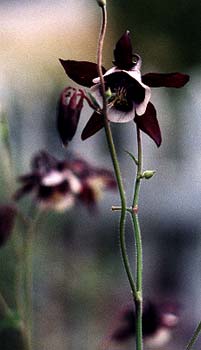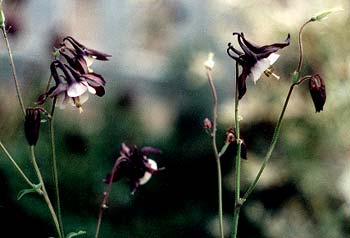
'William Guinness'
Magpie Columbine
"Columbine, open your folded wrapper,
Where two twin turtle-doves dwell!"
-Jean Ingelow
(1820-1897)
(1820-1897)
In our yard the columbine cultivar 'William Guinness' has continued to bloom until very late. Though the normal bloom time is May & June, the photos on this page were taken in August, when it was still at the height of its beauty. The only trick to keeping them beauty is to deadhead them before they go to seed.
There are two of these planted underneath the Chokecherry Tree sticking up out of a groundcover of Bunchberries. They were obtained as very tiny starts & grew rapidly to two feet or so.
This is one of my favorite columbines & I would hate for it to die out of the garden, so I let its final blooms in August go to seed, hoping it will naturalize.
Columbine vulgaris cultivars have delicate foliage & add texture to the garden even when not flowering. When in bloom they are small enough to be subtle rather than gawdy, but ornate enough to be eye-catching charmers. They are attractive to hummingbirds & butterflies.
They're cold-hardy to minus 30 degrees or even colder, dying to the ground in the coldest winters but coming back in spring. They tend to wear out in a few years much as do delphiniums.
 Columbines cross-pollinate in the yard awfully easily, resulting in Mystery Columbines after randomly hybridizing on their own. This can be an interesting process in & of itself, & I wouldn't greatly mind if, say, the pink 'Woodside Gold' cross-pollinated with 'Ruby Port' or some other A. vulgaris variety, so that they reproduced with the appearance of neither parent.
Columbines cross-pollinate in the yard awfully easily, resulting in Mystery Columbines after randomly hybridizing on their own. This can be an interesting process in & of itself, & I wouldn't greatly mind if, say, the pink 'Woodside Gold' cross-pollinated with 'Ruby Port' or some other A. vulgaris variety, so that they reproduced with the appearance of neither parent. But I really like the maroon-chocolate with white-chocolate-frill coloration of 'William Guiness,' which is also called a Magpie Columbine because of the contrasting colors akin to magpies. I rather hope it will self-seed true to the parent. For this reason I've planted no other A. vulgaris cultivars in its vicinity, though there is still a risk of it hybridizing with a different species, as there are AA. alpina, canadensis, flabellata,& siberica scattered about the same side of the house.
As I add other columbines here & there around the house, I continue to avoid putting any A. vulgaris on the side with 'William Guinness,' merely to see if it is possible that that one will seed true & not cross with other species.
If not, I'll try to remember to dig up the clump a couple years from now to divide that, though columbines are not notably long-lived as perennials, so it remains to be seen if I have that chance. At worst, if 'William Guiness' does eventually vanish from the yard, it's not a rarity, & I should be able to plant it from scratch & have it a few years more.
Continue to:
Columbine 'Black Barlow'